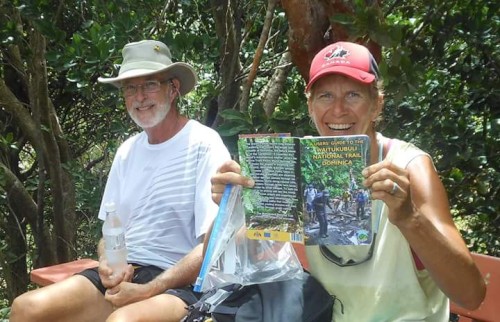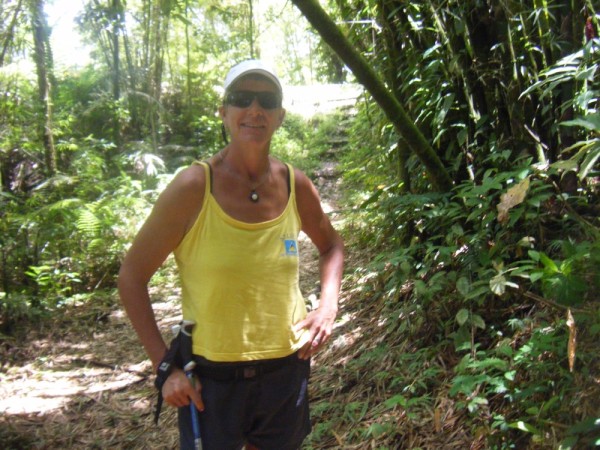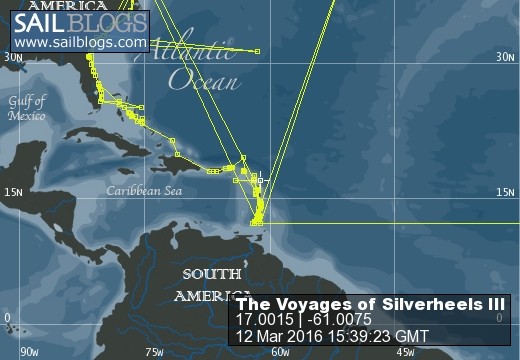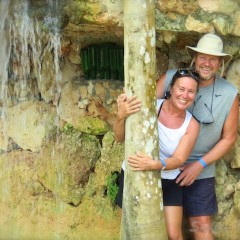
The Voyages of s/v Silverheels III
...a virtual ship's logbook, and some thoughtful (unabashed?) reflections on our sea-going experiences.
04 November 2017 | Somewhere in the Eastern Caribbean
18 October 2017 | Le Marin, Martinique in the French West Indies
25 January 2017 | Gosier, Guadeloupe
19 January 2017 | Le Gosier, Guadeloupe
19 January 2017 | Le Gosier, Guadeloupe
19 January 2017 | St Pierre, Martinique
06 January 2017
01 January 2017 | Fort Du France, Martinique
28 December 2016 | Grand Anse d'Arlet, Martinique
24 December 2016
14 November 2016 | St Anne, Martinique
06 October 2016 | St Anne, Martinique
04 October 2016
20 July 2016 | Rodney Bay, St Lucia
15 June 2016
15 June 2016
13 June 2016
13 June 2016 | Grand Anse d'Arlets
13 June 2016 | Grand Anse d'Arlets
09 May 2016 | Deshaies, Guadeloupe
Micro Economics of Eastern Caribbean Cruising
03 March 2016 | Jolly Harbour, Antigua
Lynn
We’ve been in the Eastern Caribbean for 6 years now. We left Canada almost 8 years ago now. The time has flown by, and each year we think we have gained a little more knowledge and we have certainly gained a little more experience. We have met many people, and said good bye to a number of them that have gone on to cruise in other areas, or have finished the cruising part of their lives and have gone back to what some may consider the real world. To answer the question that some might be asking themselves right now: we have no long term plans, and have no idea as to how long we will be doing this. We certainly are not ready to stop yet.
One of the frequent questions that comes up with those who want to start cruising is “how much does it cost a month?” The only partly facetious answer is “however much you have”. We know people who have tried to set a strict budget of $1,000 USD/month, and we know others who probably spend quite a bit more than that. It depends on if you like to hit every beach bar for happy hour, or are happy to have one drink on the boat at sundown. Dinner out, or market shopping and local products. We tend to be on the lower scale of the budget range, and have learned a few things, that I am going to share, along the way.
For medical stuff, we don’t have travel insurance. With Ken’s age (over 65) it would cost about $150 USD or more a month for coverage, just for him…. If we can get it. With a doctor’s visit costing about $40 USD (after this, all numbers are USD unless I state otherwise. Yes, we are Canadian, but the Eastern Caribbean dollar has a fixed exchange rate with the American, so it is easier to make conversions that mean something. Currently, our Canadian dollar, well, sucks). We do not have coverage from Ontario any more, as we have been gone too long. Health care here, for us, is affordable. Most medications are much less expensive here than in Canada, and even more so than the US, except for Ken’s migraine pills, they are far more affordable in the French islands than anywhere else (compare about $30 for one pill to 6 pills for the same amount… thankfully, we know the major triggers and he doesn’t get many migraines). Dental care is far less expensive down here, and Dr. Glace in Rodney Bay, St. Lucia, our dentist of choice, has numerous qualifications and a state of the art office. Dental work is a third to a half of the costs back home, depending on what is done, and the exchange rate at the time. We get our checkups down here. For blood work, if I give blood in Grenada, blood tests are free when requested by a physician.
We really enjoy our morning coffee. I mean REALLY enjoy it. Excellent quality, locally grown and processed, coffee beans can be found in the French islands for about $15/pound. I can live with that, since we paid that much 8 years ago in Toronto. Life is too short for lousy coffee, after all.
The interesting place where what is expected is not necessarily the truth is in wine. Everyone assumes that the best place to buy wine is in the French islands… well, yes and no. Sure, you can get a bottle of plonk for 3 Euros, but for something you might actually want to drink, you need to pay about 8 Euros. Equally enjoyable wines, although not French, can be found in the English islands for less. I personally think French wines are over rated, and some lovely wines from Chile, Australia, and South Africa can be found for about $7-$8.
Generally, cheese IS less expensive in the French islands, but cheddar is not bad in the English islands.
If you can buy and use local stuff, you will come out farther ahead. Breadfruit and plantain are great, and when you can get local tuna and mahi for less than $3.50/pound, you can’t go wrong. Many cruisers are happy to wet a line and catch their own, but for a variety of reasons, we don’t. The best expression for this is “buy the best you can get, and cook it at home”. We’ve had more than one disappointing meal. Some of the local produce is divine, and once you have had a grapefruit from Dominica, well, there is no going back. And bananas that are locally grown are beyond belief.
When we want to grab a bite to eat, we tend to go for lunch. We ask the bus drivers where they grab lunch; it will be good and affordable. For a better dinner out, we ask where they would take their mother… not a dat. The food must be good and it can’t be too chintzy, but (hopefully) the guy isn’t trying to impress someone to get laid. And you have to treat Mom right, after all. We used to be sticklers for wanting “local” food, but after a while, ground provision with some kind of stewed meat and rice does get boring, so the other day we had a great shawarma when we were in St. John’s. It is also something I don’t make. I can make breadfruit and other provision quite well, often better than the locals, now. When we are in the French islands, a baguette and some cheese from a supermarket works very well for us. We buy drinks from stores, not bars, when possible.
Buy local rum, and not in the French islands. I enjoy rhum agricole, Ken does not, and it is far, far less expensive in the English islands to buy rum (where, generally, the rum is more to what most of us know rum to be like). For smokers, buy your tobacco in the English islands, and see if the duty free option, that we can often avail ourselves too, is a better deal. 7.50 Euros as opposed to about less than $3… no brainer there.
Fuel in cheaper in the English islands. End of story there. Some places have a duty free option, so ask about that.
St. Martin is duty free, but bear in mind that every bit of food must be imported in. They don’t grow anything there to speak of. The canned/prepared food is not too bad, but produce is not particularly great, or cheap. From Guadeloupe and south, you will find better produce (and it is cheaper in the English islands).
Antigua is an excellent place to look for some shoes and other things in their cruise ship area (duty free) and there is a whole lot more than just souvenirs and jewellery to be found there.
We look for cash and carry type stores for stocking up. We have also discovered some local brands that we enjoy, especially in condiments.
The brain certainly works overtime with exchanges rates and comparing prices.
One of the frequent questions that comes up with those who want to start cruising is “how much does it cost a month?” The only partly facetious answer is “however much you have”. We know people who have tried to set a strict budget of $1,000 USD/month, and we know others who probably spend quite a bit more than that. It depends on if you like to hit every beach bar for happy hour, or are happy to have one drink on the boat at sundown. Dinner out, or market shopping and local products. We tend to be on the lower scale of the budget range, and have learned a few things, that I am going to share, along the way.
For medical stuff, we don’t have travel insurance. With Ken’s age (over 65) it would cost about $150 USD or more a month for coverage, just for him…. If we can get it. With a doctor’s visit costing about $40 USD (after this, all numbers are USD unless I state otherwise. Yes, we are Canadian, but the Eastern Caribbean dollar has a fixed exchange rate with the American, so it is easier to make conversions that mean something. Currently, our Canadian dollar, well, sucks). We do not have coverage from Ontario any more, as we have been gone too long. Health care here, for us, is affordable. Most medications are much less expensive here than in Canada, and even more so than the US, except for Ken’s migraine pills, they are far more affordable in the French islands than anywhere else (compare about $30 for one pill to 6 pills for the same amount… thankfully, we know the major triggers and he doesn’t get many migraines). Dental care is far less expensive down here, and Dr. Glace in Rodney Bay, St. Lucia, our dentist of choice, has numerous qualifications and a state of the art office. Dental work is a third to a half of the costs back home, depending on what is done, and the exchange rate at the time. We get our checkups down here. For blood work, if I give blood in Grenada, blood tests are free when requested by a physician.
We really enjoy our morning coffee. I mean REALLY enjoy it. Excellent quality, locally grown and processed, coffee beans can be found in the French islands for about $15/pound. I can live with that, since we paid that much 8 years ago in Toronto. Life is too short for lousy coffee, after all.
The interesting place where what is expected is not necessarily the truth is in wine. Everyone assumes that the best place to buy wine is in the French islands… well, yes and no. Sure, you can get a bottle of plonk for 3 Euros, but for something you might actually want to drink, you need to pay about 8 Euros. Equally enjoyable wines, although not French, can be found in the English islands for less. I personally think French wines are over rated, and some lovely wines from Chile, Australia, and South Africa can be found for about $7-$8.
Generally, cheese IS less expensive in the French islands, but cheddar is not bad in the English islands.
If you can buy and use local stuff, you will come out farther ahead. Breadfruit and plantain are great, and when you can get local tuna and mahi for less than $3.50/pound, you can’t go wrong. Many cruisers are happy to wet a line and catch their own, but for a variety of reasons, we don’t. The best expression for this is “buy the best you can get, and cook it at home”. We’ve had more than one disappointing meal. Some of the local produce is divine, and once you have had a grapefruit from Dominica, well, there is no going back. And bananas that are locally grown are beyond belief.
When we want to grab a bite to eat, we tend to go for lunch. We ask the bus drivers where they grab lunch; it will be good and affordable. For a better dinner out, we ask where they would take their mother… not a dat. The food must be good and it can’t be too chintzy, but (hopefully) the guy isn’t trying to impress someone to get laid. And you have to treat Mom right, after all. We used to be sticklers for wanting “local” food, but after a while, ground provision with some kind of stewed meat and rice does get boring, so the other day we had a great shawarma when we were in St. John’s. It is also something I don’t make. I can make breadfruit and other provision quite well, often better than the locals, now. When we are in the French islands, a baguette and some cheese from a supermarket works very well for us. We buy drinks from stores, not bars, when possible.
Buy local rum, and not in the French islands. I enjoy rhum agricole, Ken does not, and it is far, far less expensive in the English islands to buy rum (where, generally, the rum is more to what most of us know rum to be like). For smokers, buy your tobacco in the English islands, and see if the duty free option, that we can often avail ourselves too, is a better deal. 7.50 Euros as opposed to about less than $3… no brainer there.
Fuel in cheaper in the English islands. End of story there. Some places have a duty free option, so ask about that.
St. Martin is duty free, but bear in mind that every bit of food must be imported in. They don’t grow anything there to speak of. The canned/prepared food is not too bad, but produce is not particularly great, or cheap. From Guadeloupe and south, you will find better produce (and it is cheaper in the English islands).
Antigua is an excellent place to look for some shoes and other things in their cruise ship area (duty free) and there is a whole lot more than just souvenirs and jewellery to be found there.
We look for cash and carry type stores for stocking up. We have also discovered some local brands that we enjoy, especially in condiments.
The brain certainly works overtime with exchanges rates and comparing prices.
Comments
| Vessel Name: | Silverheels III |
| Vessel Make/Model: | Hinterhoeller, Niagara 35 Mk1 (1979) |
| Hailing Port: | Toronto |
| Crew: | Lynn Kaak and Ken Goodings |
| About: | After five summers and winters living on our boat in Toronto Harbour, we've exchanged those cold Canadian winters for Caribbean sunshine. "Nowadays, we have ice in our drinks, not under the boat." |
| Extra: |
The completely biased and unabashed musings from the crew of Silverheels III

Who: Lynn Kaak and Ken Goodings
Port: Toronto




















